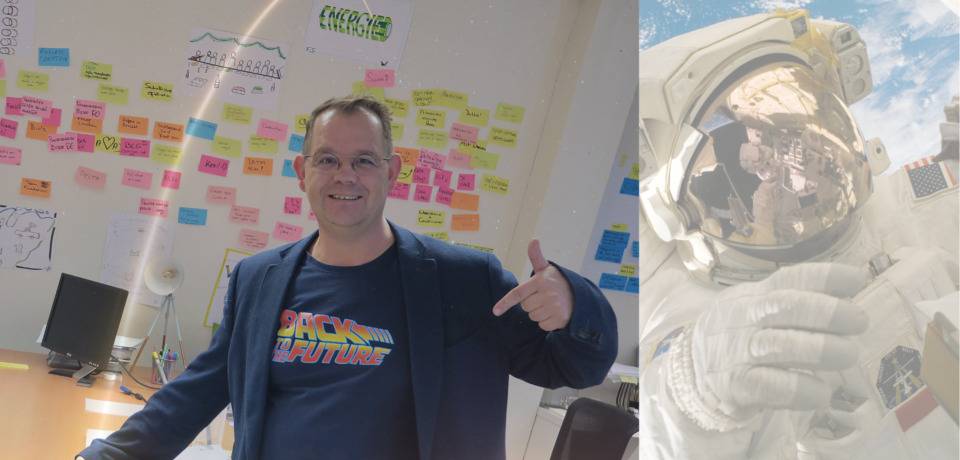“ This is Marty McFly, Marty created his own VUCA!
Marty is smart. Be like Marty”
We live in uncertain times where nothing we got used to seems to stick around for long.
Just pick up any paper, turn on the news or simply go to your day job. Economic instability, rising sea levels, corporate restructure, you name it. Everything seems to be changing all the time and the news is…… it is only getting worse! The problem is, most people don’t like these changes.
Like Margie Warrell of “Forbes School of Business & Technology“ puts it well:
There’s no doubt about it, uncertainty can be uncomfortable. We human beings are wired to want to control our environment. We enjoy the stability that comes from having continuity between our past and future, a future that is familiar, stable and predictable. We like to feel that we are masters of our own ship, in control of our fate, and so it’s entirely natural to find ourselves feeling a little out of sorts when our future becomes an unknown quantity.
In short, We don’t like change but we have to find a way to deal with it because we are living in a VUCA world nowadays. (VUCA : Volatile, Uncertain, Complex, and Ambiguous)
- Volatile because change has always been the only constant in life, but the speed in which it is happening now has never been seen before.
- Uncertain since we lack the ability to predict the outcomes of these changes more and more.
- Complex: Complexity is increasing exponentially when we can no longer see a clear cause-and-effect chain and
- Ambiguous: Ambiguity is rising hand in hand with the haziness of reality.
This might seem to be a recent development, but I disagree.
Already in the first Back to the Future film, Doc Emmet Brown and Marty McFly had to deal with a VUCA world. Even back in 1955!
Being transported (by coincidence) from 1985 to ’55, they had to find a way to travel “back”.
Marty’s need to be able to travel back to the future is the lightning strike in the clock tower of Hill Valley. It is this bolt of lightning that gives the DeLorean the necessary 1.21 Jigowatts that it needs to travel 30 years forward in time. That is all fine, but how did they know the exact second when the lightning would hit the clock tower? Sure, Marty had conveniently brought a newspaper with him from the future, saying “Clock Stopped at 10:04” — this explains how they knew the very minute lightning would strike. But unless the article stated the exact second the clock tower was hit, there would have been no way for Doc and Marty to know. If anything, it appears that Marty traveling back in time via lightning was just a shot in the dark, with a 1 in 60 chance of success — not great

Volatile? Yes, because just before the lightning strikes the clocktower, the connecting cable is knocked down by a tree so Doc has to connect both cables ends with his bare hands. Uncertain and Complex?, Hell yeah! And how Ambiguous do you want it to be if your aim is to travel in time? But…they still did it! And successfully!
Your future hasn’t been written yet, No one’s has. Your future is whatever you make it. So make it a good one. — Doc E. Brown —
Why were they successful? Because they embraced their challenging VUCA environment and transformed it to their own benefit. Just like you can create your own new VUCA to deal with the world of today, they used the same letters in the acronym but gave them a totally different meaning:
- Vision: Doc did not know for certain if his idea would work but he had a straight vision on his goal! “No matter how bringing Marty back to 1985″ was his True North. Just like today’s leaders need to be able to see through the chaos and have a clear vision for their organization or department. Having a True North helps you in effectively keeping external events at bay.
- Understanding: With a firm vision in place, you need to gather a profound understanding of your challenges ahead to be able to take advantage of the rapidly changing circumstances. To do so, be open to new and not yet explored sources of information instead of relying on the insights that feel familiar. Just imagine if the Doc of 1955 would not have been open to the idea that 30 years later he would invent the time machine. What if he had just slammed the door in Marty’s face because he did not trust his unbelievable story?
- Courage: In Marty’s case it is obvious he showed this part of his character by racing his car straight into a lightning strike… But leaders of today also need the courage to face the challenges they have to encounter every day and make bold decisions that are risky and go off the beaten track. They cannot afford to safeguard the way of working they used in the last 10 years. Using traditional top-down approaches and avoiding criticism. Even more so, If they don’t show this courage to change today, the risk of becoming obsolete is real.
- Adaptability: Marty seemed to get in some trouble when his own mother fell in love with him instead of with his dad…. If they would not get together in ’55, he would never have been born in the future… So he adapted to this situation by staying close to his mum while at the same time paving the road for George McFly to make his move. If there was ever a time for the leaders of today to be flexible in adapting to a rapidly changing environment, it is now! Long-term big-plans-up-front do not make it and become out of date before they can even be approved. Instead of that, a flexible, Agile self-organizing team can make all the difference to be able to adapt in time.
So don’t be afraid to take chances but embrace this VUCA world with your own acronyms. If Marty McFly did not take the risks to return to 1985 even if it was uncertain if it would really work, he would have been stuck in the past. Don’t get stuck in the past!
Creating your own VUCA is a worthwhile and fun exercise to do with your team and gives you a guideline in this rapidly changing environment. Do not hesitate to contact me or one of my colleagues to have a good conversation on this topic and help you to take the next step in your future.
Want more about “Back to the future” ? Read the first article of the trilogy https://weblog.wemanity.com/en/what-companies-can-learn-from-back-to-the-future-part-i/












